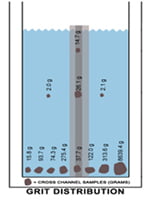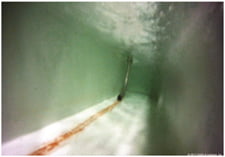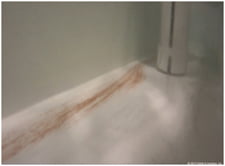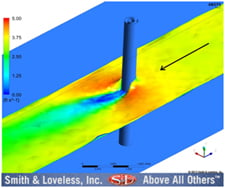The method used to collect grit during a test drastically affects the amount collected, and therefore, the results of the test.
Which Grit Testing Method is Best?
Cross-Channel Sampling (CCS)
- Developed by respected engineers and S&L in 1977 to validate equipment
- S&L approved technique; reduces the turbulence in the flume
- Ensures that truest mix of grit is obtained
- Samples collected across entire width of flume
- Sampling probe is patented 1” (25 mm) sampling probe
- Siphoning is preferred (diaphragm pumps ok as alternative)
- No submersible pumps (inaccurate grit samples with turbulence from the pump)
- Steady velocities between 2.0 and 3.5 FPS (0.6 and 1.10 m/s), with constant & steady flows
- Minimum of 500 grams (1.5 cups), combined, post-burn influent sample size
- Minimum required provides the most representative sample of how the system is performing.
- Small sample sizes do not accurately portray how effective the system is functioning.
- Use an approved, established lab experienced in processing grit samples

Example of data collected via the multi-positioned
CCS method of sampling across the channel.

A scene from a CCS grit test.

CCS Probe Samples Grit
Taken with an underwater camera, the CCS probe collects the grit along the channel floor with minimal impact on flow patterns. Because the CCS sampler does not create velocity changes in the channel, it does not disturb the flow path of the grit allowing for the CCS sampler to collect a representative grit sample and accurate grit testing.

CCS Probe Does Not Affect Velocity
When flow is introduced into the channel, the CCS sampler probe does not affect normal velocity of flume currents. The scale to the left of the figure depicts velocity levels, where blue shows the lowest velocities and red show the highest velocities in the channel. The velocity is at ideal range of 1.6 – 3.5 ft./s (0.5 – 1.1 m/s).
Vertical Integrated Sampling (VIS)
- Based on the use of a VIS sampling probe (also called VSS in places)
- Utilized by Black Dog Analytical
- Typically placed in center, in one collection location (grit is not homogenously spread in the stream)
- VIS sampler more prone to clogging.
- Brings unnecessary turbulence to the flume, disturbing grit’s natural path away from flume.
- The technique uses a “WYE” after the pump and before the sample collectors. The “WYE” has a leg straight ahead going back to the sampled flume, same size as incoming sample, with the wye split at a smaller diameter at an angle directed to the sample collector basins. Directing the small leg of the wye splitter to the sample collectors creates a problem. PROBLEM – The grit will naturally go straight.

Wye Splitting practices should be discontinued because grit will tend to go straight then suddenly flowing left and flow consistently, which can taint the sample and consequently the grit characterization results — often in the favor of lighter grit.

VIS Probe Does Not Collect True Sample of Grit
Taken with an underwater camera, the grit is introduced into the channel. The VIS sampler probe does not collect a true representative sample of grit in the left photo and in the right photo actually diverts grit away from entering the sampler opening due to the velocity change created by the VIS sampling device, which prevents the VIS sampler from collecting a representative grit sample.

VIS Probe Affects Velocity
When flow is introduced into the channel, the VIS sampler probe effects the velocity by disturbing the flume currents. The scale to the left of the figure depicts velocity levels, where blue shows the lowest velocities and red show the highest velocities in the channel. As the flow reaches the sampler opening, velocities reach 5 ft/second (1.5 m/s) around the sampler, which disturbs the grit flow and hinders collection of a representative grit sample.
Grit Testing Conclusion
As demonstrated at S&L’s Grit Removal Research Center, the Cross-Channel Sampling method collects a larger representative grit sample, while the Vertical Integrated Sampler created velocity disturbances and disrupted the flow. The VIS sampling device actually pushed grit away from the sampler. This is demonstrated by underwater photography and CFD analysis.